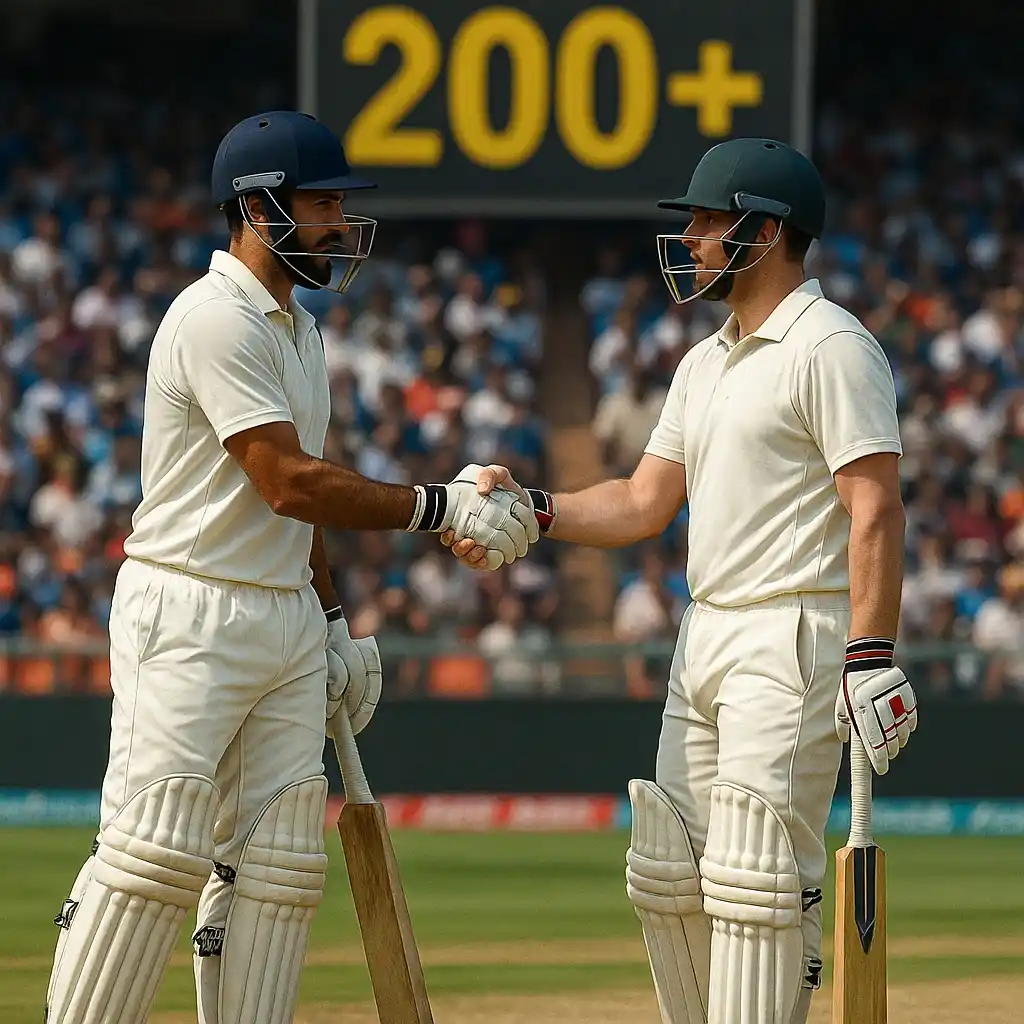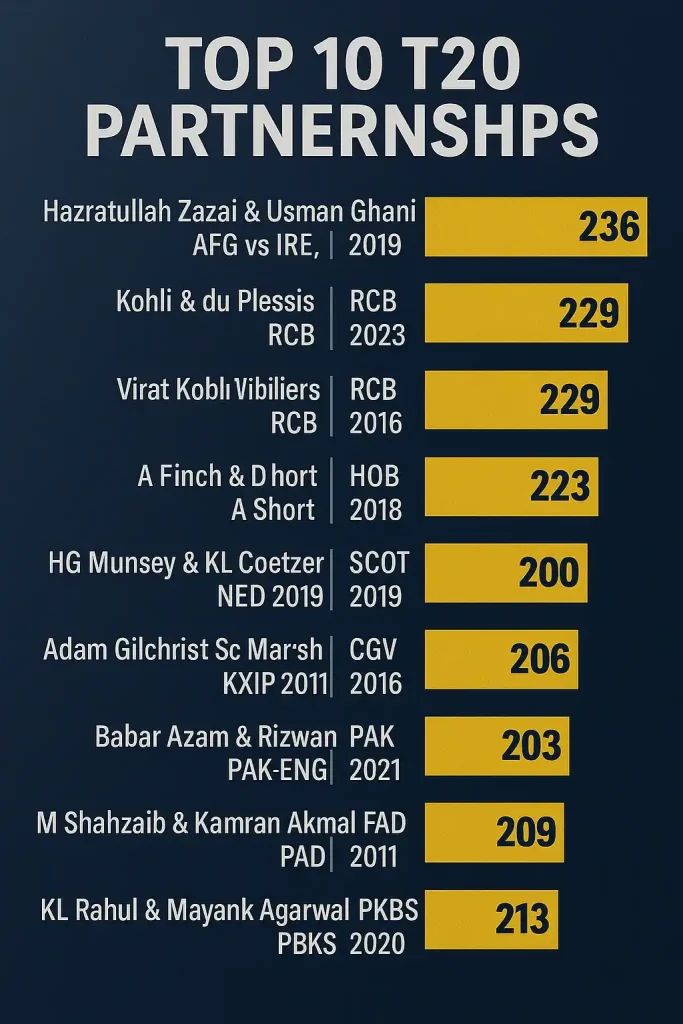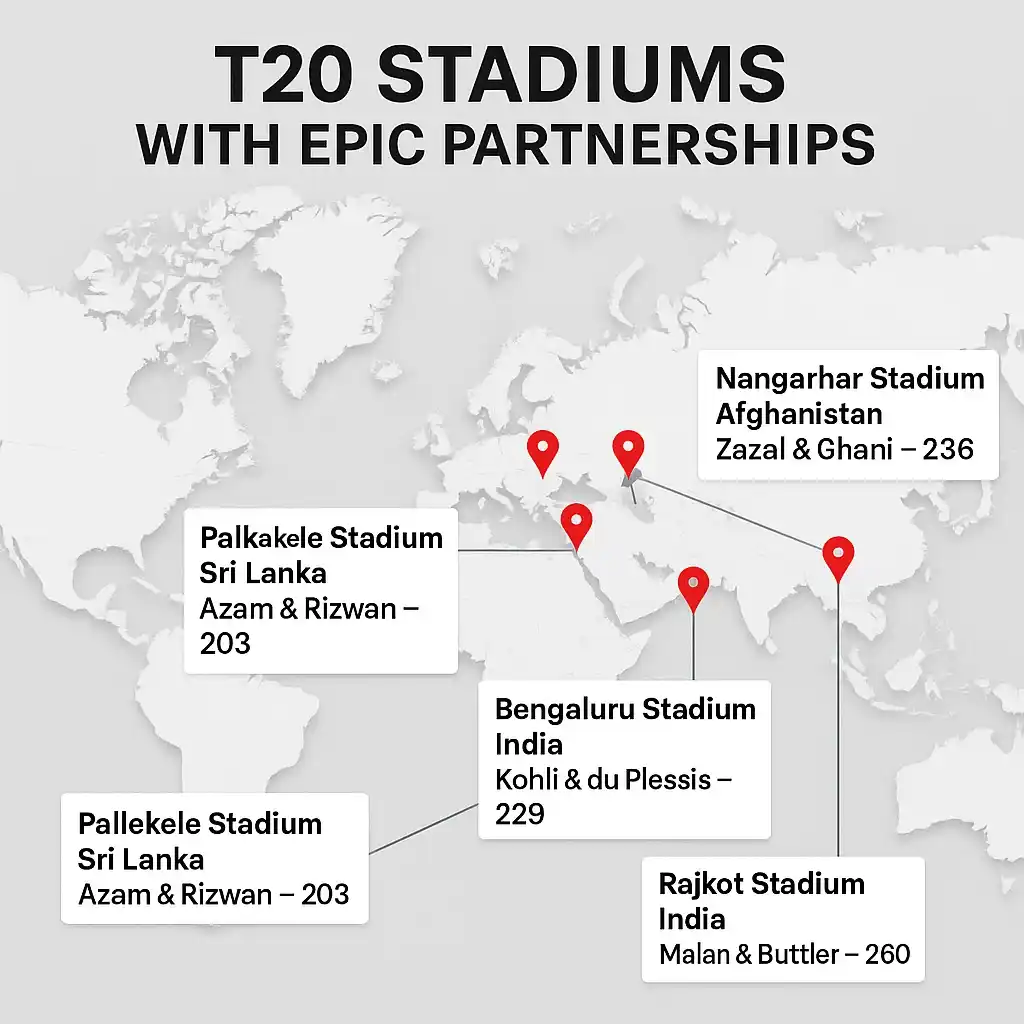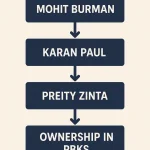
It’s easy to look at a scorecard and be impressed by numbers. 150-run stands. Strike rates over 200. Boundaries raining down like confetti. But in T20 internationals, the highest partnership isn’t just a record — it’s a rebellion against chaos. This format, with its blink-and-you-miss-it tempo, isn’t supposed to reward patience, or even structure. So when two batters hold ground, control the tempo, and destroy bowling attacks in unison, it’s more than impressive. It’s defiant. It’s calculated mayhem.
The phrase “highest partnership in T20I” gets thrown around a lot — but how often do we pause to appreciate what that really looks like under pressure? Who were the bowlers? What was the match context? How did they pace the innings? Let’s not just name names — let’s dissect what makes these stands legendary.
Why T20I Partnerships Are So Rare — And So Vital
Here’s the thing: this format doesn’t allow many partnerships to breathe. You’ve got 120 balls to work with. Every batter comes out swinging. So when two players bat deep, they don’t just build — they anchor and accelerate. It’s a balancing act between risk and ruthlessness. Most importantly, it builds pressure on bowlers. A bowling unit that’s denied breakthroughs loses more than just overs — it loses control.
That’s why the highest partnership in T20I history isn’t just about runs. It’s about dominance. It breaks the opponent’s spirit long before it breaks the scoreboard. It forces captains to rethink field settings, burns up DRS reviews, and often — silently — decides the match well before the 20 overs are done.
Table 1: Top 10 Highest Partnerships in T20I (As of 2025)
| Rank | Players | Runs | Wicket | Team | Opponent | Year |
| 1 | Hazratullah Zazai & Usman Ghani | 236 | 1st | Afghanistan | Ireland | 2019 |
| 2 | Babar Azam & Mohammad Rizwan | 203 | 1st | Pakistan | England | 2022 |
| 3 | Quinton de Kock & Reeza Hendricks | 204 | 1st | South Africa | West Indies | 2023 |
| 4 | Rohit Sharma & KL Rahul | 165 | 1st | India | Sri Lanka | 2017 |
| 5 | David Warner & Aaron Finch | 161 | 1st | Australia | India | 2018 |
| 6 | Jos Buttler & Dawid Malan | 158 | 2nd | England | South Africa | 2021 |
| 7 | Brendon McCullum & James Franklin | 156 | 1st | New Zealand | Bangladesh | 2012 |
| 8 | Alex Hales & Eoin Morgan | 152 | 2nd | England | Sri Lanka | 2014 |
| 9 | Virat Kohli & Suresh Raina | 151 | 3rd | India | South Africa | 2012 |
| 10 | Glenn Maxwell & David Warner | 150 | 2nd | Australia | Sri Lanka | 2024 |
Breaking Down the Biggest: The 236-Run Hurricane
Let’s talk about that monstrous 236-run stand between Zazai and Ghani. Not India. Not Australia. Not England. But Afghanistan — a team that was still finding its feet on the big stage. That’s what made it special. It wasn’t just the numbers. It was the audacity.
On a chilly day in Dehradun in 2019, Zazai went full throttle. 162* off 62 balls. Ghani played the perfect foil. Ireland had no answers — bowlers rotated, plans adjusted, fielders pushed back. Didn’t matter. Once the partnership crossed 150, it wasn’t about scoreboard pressure anymore. It was psychological. Ireland were beaten long before the final over.
That partnership remains the highest in T20I not just because of power, but because of synergy. Zazai took the lead, but Ghani kept the engine running. That’s what makes a great T20I partnership — complementary chaos.

What Sets These Partnerships Apart?
Not all big stands are created equal. Some come on flat tracks with nothing in it for bowlers. Others happen under lights when dew nullifies spin. But a few — the ones that stay in memory — come in tough conditions. Think seam movement, scoreboard pressure, big-match stakes.
What separates a merely good T20I stand from the highest partnership in T20I class? Timing. Game awareness. Ability to absorb pressure early and flip the switch late. Many of these partnerships began slow — 30 off 5 overs. But then came overs 6 to 15. That’s the danger zone. The acceleration phase. That’s where bowlers suffer and games tilt.
Table 2: Acceleration Phase (Overs 6–15) – Key Partnerships
| Players | Runs (6–15 overs) | SR in Phase | Total Boundaries |
| Zazai & Ghani | 124 | 245+ | 14 sixes |
| Babar & Rizwan | 108 | 180 | 10 boundaries |
| De Kock & Hendricks | 115 | 200 | 12 boundaries |
| Rohit & Rahul | 96 | 160 | 9 boundaries |
This phase — often overlooked — is where most partnerships earn their legend. Early on, it’s survival. Late, it’s fireworks. But in between? That’s the craft.
Why Highest T20I Partnerships Are Evolving
One reason these records keep getting broken? Role clarity. Modern openers aren’t just hitters — they’re planners. They know who attacks spin, who takes pace, how to rotate when rhythm is off. Partnerships today aren’t just about two batters firing. They’re about communication, strike rotation, and shared tempo.
And yes, flat pitches help. So do powerplays. But don’t underestimate how data and intent have changed the game. Batters today train in phases. Powerplay drills. Middle-overs flow. Death overs chaos. And when two of them click in sync, the highest partnership in T20I charts start shaking.

The Psychological Edge of Big Partnerships
There’s another layer no stat shows — the way bowlers unravel when a stand passes 100. Plans become reactive. Fielders retreat. Suddenly, that wide yorker becomes predictable. And that’s the danger. A set partnership doesn’t just stack runs — it steals belief.
Watch the body language. Bowlers start walking slower. Captains glance toward the dressing room. Fielders stop chirping. That’s how partnerships win matches before the 20th over even begins.
Will We See a 250-Run T20I Stand Soon?
Honestly? It’s possible. Especially with the way batting depth and confidence is trending. India’s top order has flirted with it. South Africa’s De Kock–Hendricks duo looked capable. Australia’s Warner–Maxwell pairing is electric. If the pitch behaves and both batters lock in, 250 isn’t out of the question.
What’s needed is the right storm: no early wickets, flat surface, tired bowling, short boundaries. But more than anything — trust. The best partnerships are built on it. You don’t get to 200+ without backing your partner through a few quiet overs.
Final Over Thoughts: Records Are Meant to Be Broken, But…
Records rise. Numbers shift. But impact lingers. The highest partnership in T20I doesn’t just live in stat sheets — it lives in memory. Because when two batters decide they’re going to take the game away — and do it — something about that sticks.
Next time you see a 150+ stand building, don’t just glance at the run rate. Watch the eyes. The communication. The body language. That’s where real dominance lives.
And when the scoreboard shows 200 without loss, you’ll know: this isn’t just a stand. It’s a statement.

Meet Arjun Kushaan, a passionate cricket analyst at The Cricket24x7. From street matches in his childhood to competitive college tournaments, cricket has always been a central part of Arjun’s life. With a strong background in data analysis and a natural affinity for numbers, he brings a fresh, analytical lens to the game. At The Cricket24x7, Arjun blends his deep love for cricket with his data-driven approach to deliver detailed insights and well-rounded coverage for fans of the sport.






